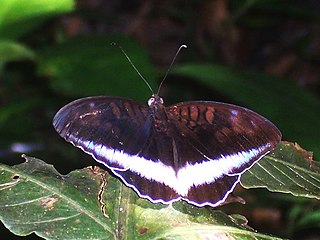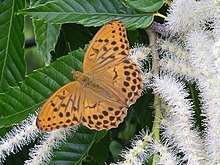
The Nymphalidae are the largest family of butterflies, with more than 6,000 species distributed throughout most of the world. Belonging to the superfamily Papilionoidea, they are usually medium-sized to large butterflies. Most species have a reduced pair of forelegs and many hold their colourful wings flat when resting. They are also called brush-footed butterflies or four-footed butterflies, because they are known to stand on only four legs while the other two are curled up; in some species, these forelegs have a brush-like set of hairs, which gives this family its other common name. Many species are brightly coloured and include popular species such as the emperors, monarch butterfly, admirals, tortoiseshells, and fritillaries. However, the under wings are, in contrast, often dull and in some species look remarkably like dead leaves, or are much paler, producing a cryptic effect that helps the butterflies blend into their surroundings.

The Heliconiinae, commonly called heliconians or longwings, are a subfamily of the brush-footed butterflies. They can be divided into 45–50 genera and were sometimes treated as a separate family Heliconiidae within the Papilionoidea. The colouration is predominantly reddish and black, and though of varying wing shape, the forewings are always elongated tipwards, hence the common name.

The Queen of Spain fritillary is a butterfly of the family Nymphalidae.

The Limenitidinae are a subfamily of butterflies that includes the admirals and relatives. The common names of many species and genera reference military ranks or – namely the Adoliadini – titles of nobility, in reference to these butterflies' large size, bold patterns, and dashing flight. In particular, the light stripe running lengthwise across the wings of many Limenitidini has reminded earlier authors of officers' shoulder marks and epaulets.

Acraea is a genus of brush-footed butterflies of the subfamily Heliconiinae. It seems to be highly paraphyletic and has long been used as a "wastebin taxon" to unite about 220 species of anatomically conservative Acraeini. Some phylogenetic studies show that the genus Acraea is monophyletic if Bematistes and Neotropical Actinote are included. Most species assembled here are restricted to the Afrotropical realm, but some are found in India, Southeast Asia, and Australia.

Boloria titania, the Titania's fritillary or purple bog fritillary, is a butterfly of the subfamily Heliconiinae of the family Nymphalidae.

Heliconiini is a tribe of butterflies in the subfamily Heliconiinae, also known as the passion-vine butterflies. This group has roughly 100 species and subspecies distributed primarily in the Neotropics.

The Acraeini are a tribe of butterflies of the subfamily Heliconiinae in the family Nymphalidae.

Argynnis is a genus of butterflies in the family Nymphalidae, one of several groups known as "fritillaries".

Issoria smaragdifera, the African queen fritillary, is a butterfly in the family Nymphalidae. It is found in Tanzania, Malawi, Zambia and Zimbabwe. The habitat consists of montane grassland on the edges of montane forests.

Issoria baumanni, Baumann's mountain fritillary, is a butterfly in the family Nymphalidae. It is found in Nigeria, Cameroon, the Democratic Republic of the Congo, Uganda, Rwanda, Burundi and Tanzania. The habitat consists of grassland, marshy areas and forest margins at high altitudes.

Issoria hanningtoni, the Hannington's fritillary, is a butterfly in the family Nymphalidae. It is found in Sudan, Kenya and Tanzania. The habitat consists of highland forests.

Fabriciana is a genus of butterflies in the family Nymphalidae, commonly found in Europe and Asia. The genus was erected by T. Reuss in 1920.












